
|
 |

|
 |
The Chandrasekhars - Lalitha Venkat, Chennai e-mail; lalvenkat@yahoo.com Photos: Lalitha Venkat August 19, 2011 (The interview was done on January 10, 2011. It was specially commissioned by the dance annual Attendance for its 2011 issue focusing on dancing couples of India. This is the full length version and an edited version was featured in Attendance due to space restriction) 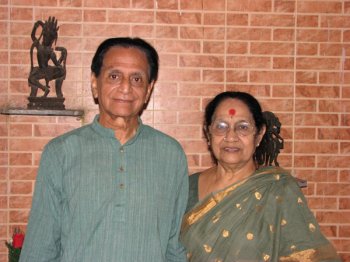 He does not like to be called Guru CV Chandrasekhar, or even Prof. CV Chandrasekhar. He says he likes to be called just CV Chandrasekhar. One of India's senior most Bharatanatyam dancers, he imbibed the best of Indian art, culture and aesthetics from his mentor Rukmini Devi Arundale in Kalakshetra. He served the Benares Hindu University and retired as the Head and Dean of the Faculty of Performing Arts of MS University of Baroda. Having moved to Chennai subsequent to retirement, he remains one of the most sought after teachers of dance and choreography. CV Chandrasekhar is a multi-faceted personality being a dancer, choreographer, researcher, musician, academician, composer and highly acclaimed teacher of Bharatanatyam. He has been performing for the past six decades in India and all over the globe and is invited by many dancers the world over to teach and to choreograph. His presentation of Bharatanatyam technique is at its finest and continues to be an inspiration for all dancers. He has a number of music and dance compositions to his credit and his dance dramas have been highly acclaimed for their individuality and innovative approach. Jaya Chandrasekhar trained in Bharatanatyam under Lalitha Sastri in New Delhi. She has been an invaluable partner to CV Chandrasekhar, accompanying him as a dancer, vocalist, nattuvanar and co-choreographer throughout the years. As they answer my questions, they take a dreamy walk down memory lane. All those years ago when not many took to dance, especially males, what inspired you to enroll in a dance school? I myself didn't know I would be inducted in a dance school. My father was a great connoisseur of music and I started learning music at the age of 5. When I was 10 years old, he felt the music education I was getting in Delhi was not enough. Probably I was promising at the time, so he enquired with violinist Madurai Subramanya Iyer who was teaching in Kalakshetra, who suggested that I could continue my education as well as learn music in Kalakshetra and he would take care of me. I came here in 1945 and for one year I learnt only music, but I think I had a latent craving for dance. Even when I was 6 or 7, seeing that I had an inclination for dance, my school teacher taught me a couple of padams. The first padam I learnt was "Velavane unnai thedi," a shringaric padam. I didn't even know the meaning of it. Those days, a boy dancing was not acceptable, so I was made up as a girl. I had on a wig and wore a borrowed pavadai chattai (full skirt and blouse) and danced with my partner in Shimla. That was my introduction to dance. My sister has told me I used to compose music when I was young and dance for it. I don't remember but she even sang the song I composed when I was 6! So dance seems to have been in me. I used to peep into the dance classes at Kalakshetra. This news went to my father and Athai (Rukmini Devi) wrote to him suggesting that I be trained in both dance and music. My father told her I was totally in her hands and she could mould me into whatever she wished. Thus I started learning dance. I stayed at the hostel and was one of the earliest students. Pasupathy, Rajamani, Adyar Lakshman and his brother Rama Rao were already there. So, I attended school as well as learnt at Kalakshetra and enjoyed both immensely. Within 6 months of my starting dance, Athai cast me as the kattaikaran in Kutrala Kuravanji. That's how I came into dance, thanks to my father's interest and Rukmini Devi picking up from there. The boys in the hostel used to tease me that I would become girlish if I learnt dance, that I would get flat feet, I would not grow tall and so on. But my good sense prevailed. I continued till I completed my SSLC in 1950. By then, I already had 4 years of dance training. Athai herself was the deciding factor and wanted to do my arangetram, so I had my arangetram in 1950. Athai asked me to stay on in Kalakshetra and go to Vivekananda College. College admission those days was not the rat race it is now, so I joined Vivekananda College. I actually wanted to study medicine. Athai said that would take up much of my time and dance would be impossible, but I wanted to become a doctor since my brother was one. She asked me to think it over. And that's how I stayed on here to do my B.Sc in Botany and stayed in Kalakshetra for 9 years. As a student of Kalakshetra (1945-54), what values did you imbibe from Rukmini Devi and the teachers that you have carried with you till now? Whatever I am today, the values I abide by today, is basically what I imbibed in Kalakshetra. Those were days when everybody learnt dance and music not to be a professional. I never dreamt that I would take up dance as a profession. I just enjoyed dancing and singing. In Kalakshetra, we were exposed to the presence of great people and learnt how to respect them. We saw how these old people were so loving towards us. So when I grew up, I wanted to be like Budalur sir, like Vasudevachariar thaatha and other selfless teachers. They never wanted anything for themselves. They always gave. This influenced me. I felt I should never demand something with my art. That's probably why I stuck on to a teaching job in a place where I got my monthly salary. It had its own advantages and a lot of disadvantages too. Values have changed today. They say, we have worked for it; so let them pay, we will dance; let them pay, we will sing. That attitude has not come into me. I am happy for I have received enough. Now it is govt funded, but when I was in Kalakshetra, there was paucity of funds. We had to go beg or borrow for a performance. For a veshti like the one I am wearing now, I had to beg someone from Theosophical Society. Prof. Trilokikar would happily give me his yellow angavasthram (to wear as sash for dance) when his wife was not around as wives tend to be strict about such matters! Like that, if someone were to come and ask me for something, I would give it to them. Strict possessiveness over things is gone. Simplicity of life. We had to do everything from getting used to sitting down on the floor, learning to share dishes, to washing our own dishes and clothes at hostel. To keep your inner self clean as well as your outer surroundings. Even this morning, I was up at 4.30am and because I had been busy with rehearsals, I decided it was time to clean my house! In Besant School as well as in Kalakshetra, we never even knew how great the teachers were. It never occurred to me to give them something in return. So many things are demanded nowadays before teaching items or to do an arangetram. I have conducted only 5 arangetrams in my life, two of which are of my daughters and one was my first student in Benares! In Benares, I conducted many performances but was not paid because they did not realize the teacher has to be paid! I did not ask because I had never given anything to my teachers! That's a value I imbibed and even today, I never ask even when I go abroad. I ask them to give what they want. I don't have a job now so I won't refuse because I need to live. I feel nobody has cheated me. They have all been nice and kind to me. If I had demanded, probably they would have a different opinion about me. Both Jaya and I never, never ask for anything. The greatest value I learnt is to respect art and not make it a business. Whenever people visit us, they bring us fruits. I had never given anything to my music teacher Budalur sir, so for my daughter's arangetram, I took some fruits and gave it with a veshti and angavastram and prostrated before him. I felt his tears on my feet. He said he was so happy; they were not used to receiving gifts like this. I think these youngsters have spoilt us by giving us so much, that after some time, one starts expecting! When Rukmini Devi stood on the stage, she would be like a beautiful apsara. Whatever she wore, even with washed hair, she looked beautiful. Everything around her was beautiful. That aesthetic sense is something that I developed from her. She might have scolded us at sometime or other, but those things were all forgotten. The institution has given me so much. She would ask me to come and teach there. Sankara Menon sir would tell her to pay me what I was currently earning if she wanted me to, but Kalakshetra was in no position to pay anybody anything. But I knew she was happy because she knew I was not going to give up all the values I had learnt there. I learnt the aesthetics in life. Even when I performed yesterday and saw the Nataraja and lamp covered with flowers, I told the organizers I wanted the Nataraja statue as it is, for my performance. On stage, even if I spot a white thread on a black curtain, that would affect me. We learnt at Kalakshetra to pay attention to such fine details. Nowadays people dance with ugly banners behind or overdo things. Sometimes we are forced to perform, we need to dance and have to accept what is given to us, but I have always tried to put my foot down on aesthetics. My life was already decided and made in Kalakshetra and I have passed on my values to my children and try to pass on to my students, though I have not given them that atmosphere I had in Kalakshetra that Rukmini Devi gave us. Times have also changed, but I do my best. 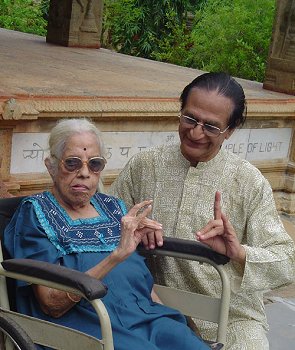 With Peria Sarada at the Hindu temple in Theosophical Society, Chennai (Oct 2005) 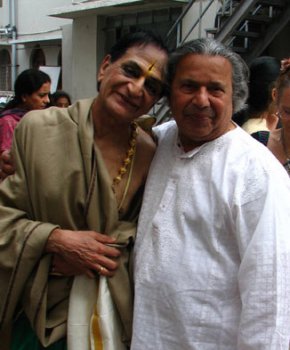 With K P Kunhiraman at Music Academy after his performance (Jan 2011) You then went to Benares in 1954 and taught at the University there from 1958 -79. What are your fondest memories of the place? Aahh, Benares! I can talk about it for hours. Everybody dreams of going to Benares at least once in their lifetime, but I lived in Benares for 26 years. I studied from 1954 to 56, then I spent a year and a half in Mussourie teaching and performing. My wife joined me when I was in Benares and our children were born there. That was the greatest gift to me. Benares was a wonderful place for the children to grow up. There was no sophistication of any sort. They studied in the Theosophical school, which did not impose religious sentiments or fanaticism on them - their philosophy was there's no religion higher than truth. They were exposed to an excellent atmosphere. Jaya was teaching at the J Krishnamurti Foundation for 13 years. She was exposed to J Krishnamurti's lectures and even today remembers so much of what he spoke every time he visited Benares. It may not be possible to agree to everything great visionaries say but the atmosphere of learning was there. We have unknowingly taken the positive points and followed them. The university was like any other university, but living in a city like Benares...it is one of the richest places for dance and music. We were exposed to some of the best musicians who came from Benares. Though there were a few earlier, we were like pioneers to make Bharatanatyam known in whole of Uttar Pradesh. We were the first to receive the Uttar Pradesh Sangeet Natak Akademi Award for dance in Bharatanatyam, otherwise it was always for Kathak. There was lot of opposition because they felt Bharatantayam does not belong to UP, and why should people from the south be honored in UP for Bharatanatyam. But it was something special that we were the first ones to be honored with a state award. Philosophy of life is what Benares taught me. Even if you have money, you don't have to flaunt it. People lived a simple life. Looking at the girl students at school where I was teaching or by visiting their homes, one could never make out that they were from very rich families. I would know of their affluence only when I did performances and would make a general statement about what I needed and they would bring such wonderful, traditional saris, lehengas and beautiful jewellery. When Rukmini Devi came to see my first performance in Benares, even she was astounded at the costumes and jewellery. I told her she had taught me to beg or borrow! Nothing belonged to the college. The principal gave me Rs.5 for expenses. That was in 1958! Philosophy of life and death...every day we would see bodies being taken to the ghats for cremation. Very often I have gone with my friends for the loss of their parents or relatives. We had to sit there for 4 hours and collect the ashes, otherwise the next body would be brought in and we would not know whose ashes or bones we were collecting. Watching the body burn for 4 hours, seeing the flames go up, the skull bursting, I would return home and tell Jaya, death can be so beautiful. Even I was scared at first but this is what life is all about. It tells you this is what is going to happen to you some day. We don't know when it will come but it is there. From the ghat, we go out and haggle with the rickshaw fellow. But finally, he and we will have the same fate. We do cry and miss our loved ones, but I learnt from this to take life everyday as it comes and death is not to be mourned. Nothing is permanent. Avoid petty feelings like anger. For 26 years I lived in Benares, but now Benares lives permanently in my heart! The moment you say Benares, I get tears in my eyes. I am so attached to the place. In what way did these years in Benares influence you in your dance career? Great musicians like Rasoolan Bai, Siddeshwari Devi, Girija Devi, Omkarnath Thakur were all like close associates. Similarly, dancers like Birju Maharaj's family, Sitara Devi's family were all close to us. My daughters were fortunate to be in such company. Before he died, when I last met Kishan Maharaj, he was telling someone proudly at Kamani Hall in Delhi, "I have been associated with Chandrasekhar-ji for many years. His daughters have come to my house and danced." Once Siddeshwari Devi even told me, "I have heard that Madrasis are very nice people. Can you please find a nice boy for my daughter?!" (Suna hai ki Madrasi log bahut acche log hein. Hamaare beti ke liye ek accha sa ladka doond le!) Such a great artiste, but a mother's concern for her daughter comes to the fore. Bismillah Khan would say whenever he was invited to America, to get him Baba Viswanath and Ganga and he would consider it. Such was the attachment artistes had for Benares. Coming in contact with so many Sanskrit scholars, listening to them and working with Dr. Premalata Sharma, a great musicologist and Sanskrit scholar, was a boon. For all my productions, I would ask her for some slokas on this or that, she would make everything ready and give it to me the next day. I owe so much to these greats for help with all my major productions. We would do Sanskrit plays with Dr. Premalata like Uttarramacharitam and Malavikagnimitram in which Jaya and I did main roles as actors. For that we had to study the Natya Shastra and Sangeeta Ratnakara. Premalata-ji used to take classes. This total enrichment prepared me for my next sojourn in Baroda. I had learnt Carnatic music for 15 years. Now I heard so much of Hindustani music in Benares. I got initiated in Kalakshetra itself when the Dagar brothers were invited to live in residence for 3 months and work - no teaching, just sing and practice. Anyone could go and listen to them. I was the only one who spoke Hindi then, so I was their pet. And so it continued in Benares and at one stage I started composing for my dance productions - Meghadootam, Ritusamharam, Brahmar Geet, all in Hindustani style. When I came to Madras and sang for my daughters' recitals, people would ask me if I had learnt Hindustani music. I used what I imbibed from both styles. I learnt the differences and nuances in Hindustani and Carnatic music. If I take a Hindi item, I would like to sing it in north Indian style, not Carnatic style. So, musically, it was a very enriching experience for me. As professor and head of department of MS University, Baroda (1980-1992), what were the challenges you had to face? How did these years in Gujarat enhance your outlook in the dance field? I was very fortunate when I went to Baroda that the academic syllabus for the degree and post graduate courses formulated by my predecessor Mohan Khokar was already in use. We had nattuvanar Kubernath Tanjorkar from Thanjavur already teaching in the department. It was all there on a silver platter so we did not have to struggle to start something new. It was the first university in the whole of India to have started dance. We were training students for exams, had our restrictions on travel, but I felt the need to showcase our talents outside Baroda. I wanted Baroda to be recognized. When I did my dance productions in Baroda, I had the entire music department as part of my orchestra - vocal, sarangi, sitar, violin, pakhawaj, mridangam, tabla... It was as if everything was readymade. I had a mridangist appointed in the dept, who would play with me all the 6 days of the week in my class. What a luxury... never in the past or in the future! Nowadays it is so difficult to get them for just one rehearsal! Through the help of friends, we would come to Chennai every year. We first performed Ritu Samharam in 1981 in Chennai, the year I got my Nritya Choodamani award. I came with 23 people of which about 10 were musicians and people still remember it. I joined the university in 1980, but by 1981, I could choreograph because the dancers were already trained. Being in an institution, I could get the dancers any time. It was a great luxury for us, unlike now...if I need 10 dancers for a production, I am at their mercy! In Benares, the students were learning other subjects and dance was an extra, but here dance was a full time course. My work style gradually started getting recognition for me and the dept. I got the dance community in the country to know that there's a dance dept in Baroda that is doing good work. My predecessors had performed in Gujarat but we travelled to other cities like Delhi, Jaipur, Kolkata and so on. For some time, I was even called Baroda Chandrasekhar. It's an old story that dance went to Baroda as part of the dowry of the Thanjavur princess. So Baroda did have a long history of dance. The students also studied about world dance like ballet or contemporary. We did not have practical classes but had visitors to the dept from all styles from various parts of India. They would give lec-dems, and left on a happy note that something good was being done here. I also introduced dissertations for MA students, so all of them who passed out did not just have practical dance learning. They were given topics to do research on. Someone from Bombay came and wrote an article on the dissertations done (on western ballet, on Sanskrit texts, sculptures in dance) in the MS University! So academic importance was given importance too. All this was very special. 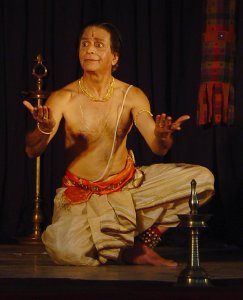 Performing on Dec 7, 2003 on the 75th birthday celebrations of Kalanidhi Narayan 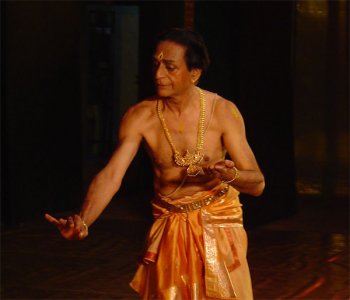 Performing at Music Academy (2004) Any differences in the Bharatanatyam performed in north India as compared to in south India? Bharatanatyam is Bharatanatyam wherever it is performed, but the only thing I would say was different is, in Benares, they loved watching Bharatanatyam. But the language....not everyone understands Telugu, Sanskrit or even Thamizh! Sometimes even with explanation, it is difficult to understand. I felt language has a very important role in communication. So, in Benares I started using Hindi and Bengali because we used to celebrate Tagore's birth or death anniversary. We would do a full show of Tagore music in Bharatanatyam. When I came to Gujarat, I knew my predecessors and in Ahmedabad too, had started using Gujarati lyrics in Bharatanatyam. That was good for propagating that language has no barrier for dance. To dance to a Hindi bhajan, Gujarati bhajan, Gujarati lyrics was all there to get closer to the audience, but I also saw to it that they learnt regular margam. Like people asking Aruna Sairam to sing abhangs in her Carnatic music concerts, nowadays in Madras also, they dance to bhajans. Some don't even understand what they are doing. I get telephone calls asking for meaning on the day of performance! As a national lecturer in UGC, I had to go to different dance departments in different universities. I did Bharatanatyam for Tagore music and astounded everyone at Shanti Niketan. People would ask how Hindi or Gujarati speaking girls would understand Bharatanatyam. I would respond that even our convent going children don't understand a simple song in Thamizh, or how many in Hyderabad understand Telugu songs. It all depends on how you teach them. Whether my students are Chinese or Japanese, Gujarati, Bengali or Marathi, I tell them not to take the translation of some scholar, but to translate into their own language and to emote with that vocabulary. Japanese students say they don't show emotions outside, it's all within them and they can't emote. Because of my flair for languages, I was able to communicate by talking to them, making them express in their language, and then teaching them to emote. This was a learning process for me too. Teaching in the North was in itself a learning process. I never felt it was difficult for me to teach non south Indian dance students in Baroda or Benares. In Thamizh, we have our special similes that are difficult to translate! I ask them if they have something similar in their language. I changed my way of teaching. Both Jaya and I talk a lot when we teach. It was necessary to talk and sing too. Many of my students did not want anyone else but me to sing, because they said my Hindi sounded like Hindi or Gujarati like Gujarati. It was a great experience for me as a teacher to cater to different types of people. 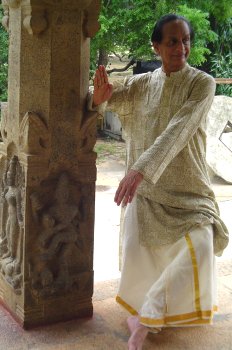

At the Theosophical Society Hindu temple (Oct 2005) Once you returned to Chennai in 1996 after the long stint in the north, what did you have to contend with? When I came to Chennai, I had my own apprehensions. I did not know how we would be received in Chennai. I did not know the young people in the field. 40 years is a long period to be away from Chennai. When I was in service at the university, I could not get leave and whatever I wanted to do, I had to do during the holidays. Summer is too hot, there are no performances and there are family responsibilities too. Earlier I could not even do much of my own dancing. I did not have the guts to start my own school. But I was now free to travel whenever I wanted. I started my dance school Nrithyasree only here in Chennai. I had never taught anyone privately. According to the rules of the university, you are not supposed to, but people still would! The salary from the institution or university was just pocket money for them! They earned 5 to 6 times more with private tutoring. That was one of my values. If I am appointed and there are rules to be followed, I will follow them. In Benares and Baroda, I privately taught only a couple of boys because I wanted to teach young men to dance, and most of them would never get support from their families. This was the only private teaching I did and did not take money. I considered it a service I could do. Even after coming here, I helped some boys who came out of Kalakshetra and charged them no fee. Some girls used to tease me that I was partial to the boys and that some of them did not have much money either! I always tell them to pay whatever they can, and according to the number of classes. As long as they are happy, we are happy. In recent times, both of us decided that we would not teach children. Now we want to work only with those who want to share our experiences and who have taken up dance as their profession. We don't have any students really to reckon with because many excellent dancers that we have trained are all married, settled and have nothing to do with dance. A couple of them have become teachers but they also stopped dancing after becoming teachers because of lack of opportunity. I sometimes feel, all my life I have taught so many people, but they have not been able to make a name. That's why we decided we would teach those professionals who are already in the field because we know they will pass it on to others. One important thing I say to those who want to learn items or widen their repertoire, don't come to me. My own repertoire is much less than what most of you know. You know 40 varnams, I know only 10 all my life! I insist on every dancer paying attention to details. It is not acceptable to many, but I only do this type of teaching. Incidentally, when I am doing this, you learn an item. I used to compose some thillanas and jatiswarams and now I'm composing varnams too. After coming to Chennai, I not only compose music, but also the lyrics like the varnam "Ennai marandanalo." It gives me great pleasure and a sense of satisfaction, since I was away for 40 years and have not done anything in Thamizh. 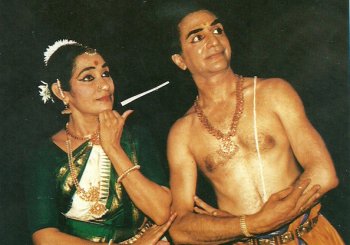 Photo courtesy: Ashish Mohan Khokar 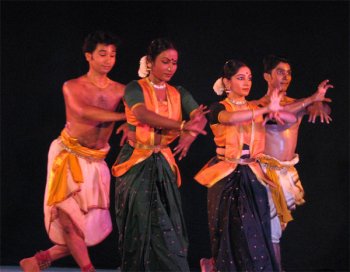 Arohanam choreographed by the Chandrasekhars (Dec 2008) I think the last time we performed together was 4 years back before Jaya got chikungunya and that has affected her knee joints. Whenever we came from Benares or Baroda, we always danced here in Chennai. Maybe one or two performances in a year. Basically we had a problem. In the north we had no help for singing. So we always danced to each other's tunes! When I danced, she would sing and do nattuvangam. When she danced, I would sing and do nattuvangam. When we went for one of the first ICCR tours to Greece, we could not dance together because they wanted live music and the mridangist, Jaya and I were considered as 3 musicians and 2 dancers! We were able to dance together only after our daughters grew up and were able to do nattuvangam for us! What are the positive and negative trends you see in today's dance scene? Young, aspiring and established dancers are all very, very intelligent. They know how to equip themselves to be dancers. From day one, they plan on what course to take, whom to learn from, how to project themselves and how to sell their dance. They are so intelligent in all this, we feel like we don't know anything. They know the tricks of the trade. I have always been very positive on my comments on young people. Many of them are very hard working and want to become great. Circumstances made dancers before. Now it's the youngsters themselves who want to and they are prepared to go here, there, approach different people, learn different items from different teachers. We could not ever think of doing all those things. It is nice to see so many dance schools putting up children's shows. But I have also heard of parents of young children who have to pay the teachers for giving their child a chance to dance in the school's production. I don't approve of these things. Most of these children who dance don't have to be paid, instead they pay to be part of the production. We as professionals and youngsters, who aspire to be professional dancers, find this very disheartening. I don't know where this is going to lead. Your comments on the male dancers of today - their situation, struggle, more as teachers than performers... I don't want to crib about these things, but dancing well has never helped me get more performances, especially being a male dancer. But now there are so many wonderful male dancers and they are all doing so well. Some of my male students tell me not to worry, that they know more than me on how to make money in dance, how much to demand to conduct an arangetram, and they get it too! I'm holding on to my values of not asking but I'm not unhappy about it. I'm at the fag end of my life. The only thing I tell them is, make money but don't cheapen yourself. If you don't like to do something, don't do it. Don't have double standards. Your conscience must be clean. The presence of many of my students in a group gets the group a good name. I'm happy for the person who makes use of them. My students go to so many places to dance in other people's productions. If only those organizers could arrange a solo performance for these dancers, how rewarding it would be. It could so easily be done but perhaps they don't want the girl or boy to steal the limelight, so they don't give the opportunity. When you know you are indispensible, you could put down your cards. It's not even the money, but such opportunities are hard to come by. They should all be dancing so much more but they don't get the chance. I have never approached a sabha for performances and some years we have gone dry. Many of my male students have told me that when they give their biodata to the sabhas, they just throw it away, without even a glance. Lot of organizers feel only female dancers draw a crowd, but that is not so. For even established names, there are sometimes only 40 people in the audience. That's why when Natyanjali Trust wanted to honor me, I asked Jayalakshmi Sadagopan's daughter Prema Satish to have an exclusive dance festival, mainly for Chennai male dancers. The Nartaka Festival was my initiative. Now it has picked up and this year there were dancers from outside Chennai and India too. It is a great encouragement for male dancers. I feel more male dancers are dancing now and the situation is much better than what it was before. There are also other festivals for male dancers now. I'm so glad that Ashish Khokar has started these awards for male dancers. It is high time this was done. There's a lot of demand for dance now. Before, nobody used to send their girls to a male teacher. Now it does not bother them. So there is definitely an improvement. Also, many male dancers get married to female dancers and as a couple, they get better performance opportunities. Even at 75, you continue to perform. I sometimes feel I have not danced as much as I would have loved to. That regret will be with me for my life. But I'm happy that god has been kind to me. After I retired, after turning 60, I have been dancing and doing at least 10 programs every year! As I'm growing older, many people want me to dance, even overseas! This is happening at a time when I know how much energy I need and how much my body can take, for rehearsals and so on. People say I don't need rehearsals because I've been dancing for so many years. I ask them, who told you that? How can I perform a varnam or thillana without rehearsing? I got the Kalaimamani award in 2003. People thought I had already gotten it 30 years ago, and asked me why I accepted it. When I'm given something, I don't want to make a fuss about it. One must accept it with grace, whenever it comes. Without asking for anything, like a bolt from the blue, I got the Kalidas Samman, a very prestigious award. What is the secret of your boundless energy? I don't know. Everybody has been asking me this. I think it's just the passion that makes me go. It's not that I am 100% well. Sometimes when I walk fast, I get a little pain here. When I don't dance for a while and I suddenly get a program, I take my rehearsals at an easy pace, doing an alarippu, give a day's gap, then a jatiswaram, another day's gap and gradually build up to varnam. I will then proudly tell Jaya I practiced the whole varnam that morning! I know my limitations and how I should work. The concern people have for me and my health is so heartening. Some even tell me it is enough for me to dance for just an hour, that I am precious to them! I tell them, my life is precious to me too! If anything is to happen, it is not in my hands. Just because I danced, and something happened...I do not agree with that. I have a strong faith that my father, who sent me to Kalakshetra to train at the age of 10, is giving me his energy. And Athai whom I always think of is god sent for me and she is blessing me. Whether in darkness or light, the energy I get from the audience is immense; the energy of each one comes to me. So, I think that keeps me going. Contact: chandjay@hotmail.com Response * What humility, amazing human being, how lucky to have been influenced by stalwarts and what a full life!! May his legacy continue..God bless. - Sumana (Aug 25, 2011) *
It was a wonderful experience going through the
complete text of the interview of CV Chandrasekhar.
Thanks.
The simplicity, the honesty and the purity of
his being reflect not only in his conduct but also in
his performance. I have personally experienced the joy
and appreciation he is capable of extending towards the
younger dancers. It is a privilege to have both of them
around inanydance performance.
Looking forward to such inspiring reading. - Uma Anantani
(Sept 5, 2011) * I met sir and watched his performance at Ahmedabad during the workshop organised by Gujarat Sangeet Natak Academy on 17th Sept 2011. I was speechless and almost full of awe for his kindness, loving nature, teaching method of any topic, energy at the age of 75, and above all the aesthetics and philosophy towards classical dance. How a highly classified form like Bharatanatyam can be made contemporary within its own format of grammar and made available to people for understanding can be learned through Sir's great compositions. We are fortunate to have such people married to dance and music. I am thankful to Sir and madam for devoting their lives to dance and music. - Beena Sheth (Sept 21, 2011) Post your comments Please provide your name and email id when you use the Anonymous/blog profile to post a comment. All appropriate comments posted with name & email id in the blog will also be featured in the site. |